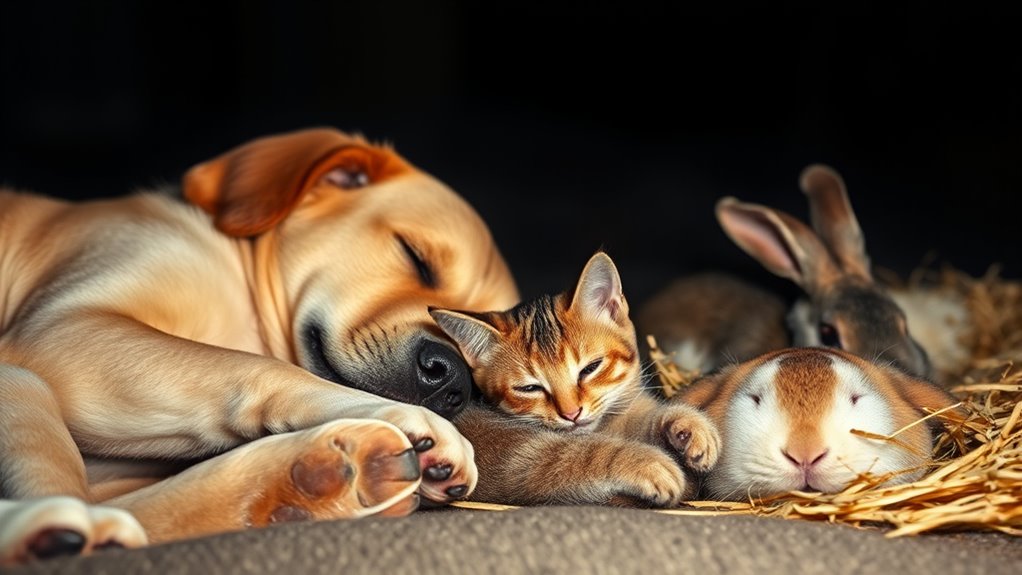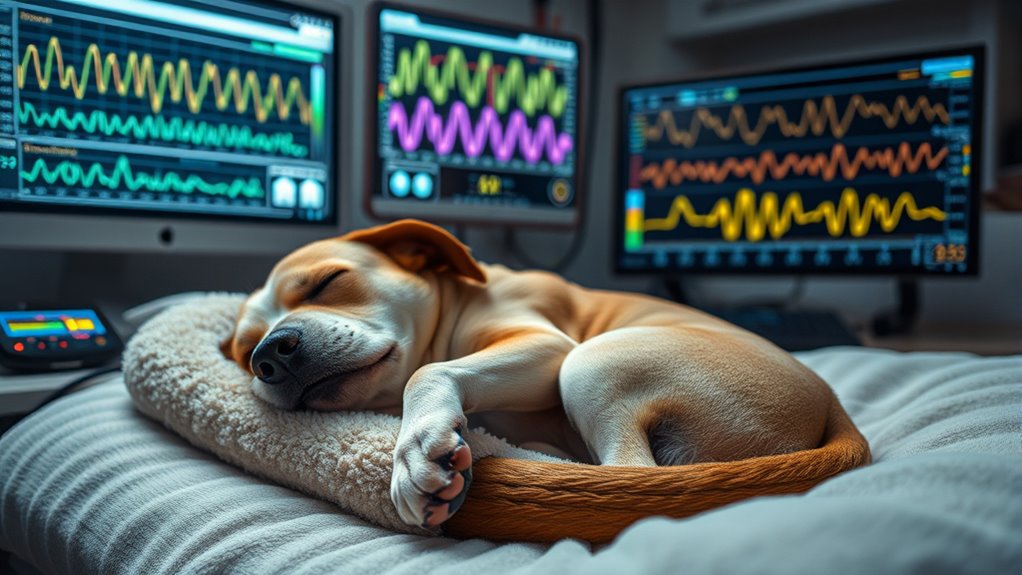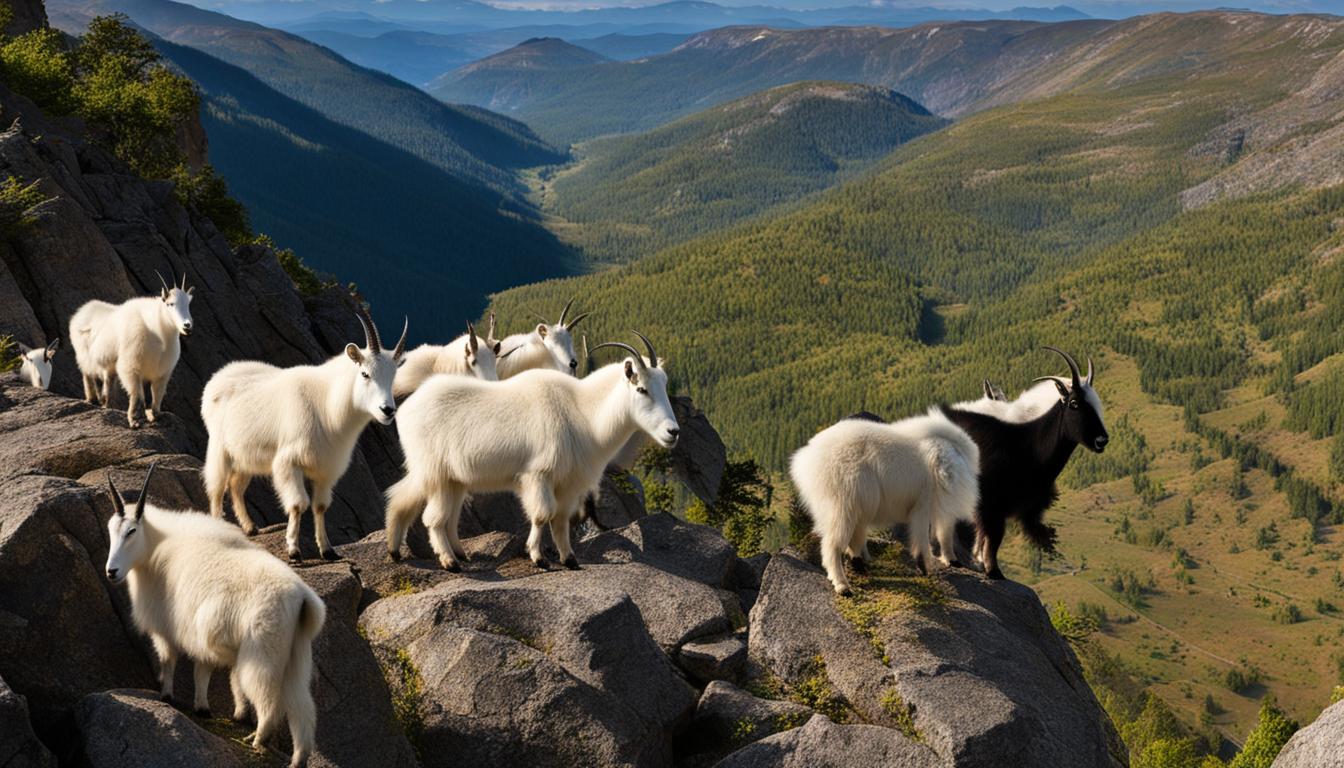Many animals, from dogs and cats to birds and reptiles, experience dreaming during REM sleep, just like humans do. This dreaming isn't merely random; it often reflects their daily experiences and may even rehearse survival skills. As you explore further, you'll discover how different species' sleep patterns reveal fascinating insights into their cognitive processes and emotional responses, giving you a deeper understanding of the animal kingdom's subconscious lives.
Key Takeaways
- Many animals, including mammals and birds, experience REM sleep, suggesting they may have dreams related to their waking experiences.
- Studies indicate that dream content often reflects survival scenarios, enhancing threat response and rehearsal for real-life challenges.
- Neural activity patterns during sleep in various species mimic those during wakefulness, indicating that memories are being processed and consolidated.
- Damage to brain areas like the hippocampus can reduce dream frequency and detail, impacting memory integration and emotional processing.
- Research shows that dreaming may foster social bonds and improve cognitive flexibility, benefiting survival and adaptation across species.
The Science of REM Sleep in Animals

While you may think of REM sleep as a characteristic unique to mammals, recent studies reveal that various non-mammalian species, including reptiles, exhibit forms of this captivating sleep phase.
During REM sleep, the forebrain shows wake-like activity, which boosts cognitive flexibility and aids memory restructuring. Curiously, species exhibit vast differences in REM sleep duration, with juveniles relying on it more heavily for simulation-based learning. Sleep is mandatory in most animals with a nervous system, highlighting its fundamental role across diverse species.
In reptiles like bearded dragons, researchers have observed REM-like sleep states, showcasing brain activity similar to mammals. Muscle twitches can occur during REM, though they're less frequent in some reptiles.
Understanding Sleep Cycles Across Species

Recent research into REM sleep highlights the complexity of sleep across different species, revealing fascinating variations in their sleep cycles.
For instance, giraffes sleep about 4.6 hours a day, while koalas can snooze for up to 22 hours. High-risk species, like elephants, tend to sleep less to stay vigilant. Interestingly, the sleep patterns of many animals are influenced by their environment and lifestyle.
You might find it interesting that some animals, such as cetaceans and certain birds, practice unihemispheric sleep, keeping one half of their brain alert.
Others, like horses, sleep standing but lie down for REM sleep. Aquatic turtles adapt their sleep to both land and water, showcasing how environment influences sleep patterns.
The Role of Memory Consolidation in Dreaming

When you think about dreaming, consider how your brain replays memories during sleep. This neural replay, particularly involving the hippocampus, helps solidify what you've learned and experienced. During sleep, animals' dreams can reflect their real-life experiences, suggesting that the process of memory consolidation is not just a human phenomenon.
Neural Replay Mechanism
The neural replay mechanism plays an essential role in memory consolidation during sleep, enabling your brain to strengthen and reorganize memories. During both REM and NREM sleep, your brain reactivates neural patterns from waking experiences, which can influence the content of your dreams. This process not only reinforces what you've learned but also enhances cognitive flexibility by transforming memories into new narratives. All observed animals exhibit SWS, which is linked to memory consolidation and retrieval, further emphasizing the importance of these sleep stages in the dream process.
| Aspect | Description |
|---|---|
| Memory Consolidation | Stabilizes and reorganizes memory traces |
| Neural Activity Patterns | Mirrors waking experiences during sleep |
| REM vs. NREM | Both stages contribute to memory reactivation |
| Cognitive Flexibility | Enhances the ability to adapt memories creatively |
Hippocampus Activity During Sleep
While you sleep, the hippocampus is hard at work, playing a crucial role in consolidating memories and shaping your dreams.
During both REM and NREM sleep, the hippocampus becomes active, reactivating neural patterns from your daily experiences. This process strengthens your memories and influences your dream content, often reflecting episodic memories. Additionally, neural reactivation during sleep supports the integration of these memories into dreams.
You might notice that your dreams are fragmented, combining various memories, thanks to the hippocampus's role in memory integration.
If the hippocampus is damaged, you may find that your dreams become less frequent and detailed, highlighting its necessity for typical dreaming.
Fundamentally, the health of your hippocampus directly impacts the complexity and richness of your dream life.
Evolutionary Advantages of Dreaming
Dreaming serves as an essential mechanism for enhancing memory consolidation, allowing you to process and integrate daily experiences more effectively.
While you sleep, your brain reactivates memories, influencing what you dream about and improving your ability to recall information. This memory replay not only aids in learning but also helps you work through unresolved problems, offering insights upon waking. Additionally, dreaming might simulate threats, enabling you to rehearse avoidance strategies that improve your survival skills. Animals likely dream about activities that relate to their daily experiences, which further highlights the connection between dreaming and memory consolidation.
By integrating recent experiences into established memory networks, dreaming facilitates learning and enhances performance in tasks you encountered before sleep.
Behavioral Evidence of Dreams in Animals

As researchers explore the fascinating world of animal behavior, compelling evidence emerges that many species experience dreams, particularly through their sleep patterns.
For instance, animals like dogs and cats exhibit REM sleep, which correlates with dreaming. During this phase, their brain activity resembles that of when they're awake, suggesting they might be dreaming. You might notice a cat arching its back or a dog barking in its sleep—these behaviors hint at dream enactment. Interestingly, REM sleep has also been observed in various bird and reptile species, further supporting the notion of dreaming across the animal kingdom.
Studies on rats reveal that neural firing patterns during sleep often mirror those from their waking experiences, indicating they could be replaying memories.
Insights From Comparative Studies of Sleep

When you look at rodent research, you'll find fascinating evidence of dream-like states that hint at memory replay during sleep. Similarly, primates show remarkable patterns where they seem to process experiences, reinforcing the idea that sleep plays a key role in memory consolidation. These insights reveal how sleep functions might be more universal than previously thought across different species. Notably, studies indicate that sleep is an active state rather than a passive interruption of wakefulness, suggesting deeper implications for understanding sleep across taxa.
Rodent Dream Research
Rodent dream research reveals fascinating insights into the nature of sleep and dreaming across species.
Like humans, rodents experience REM sleep, marked by rapid eye movements and brain activity similar to wakefulness. During this phase, their brains replay memories, helping to reinforce learning and enhance memory consolidation. Studies show that rodents often dream about their waking experiences, such as traversing mazes, indicating they possess visual imagery in their dreams. REM sleep neural mechanisms that control REM sleep in rodents further illuminate the parallels between their dreaming processes and our own.
Primate Memory Replay
Primates, like great apes, experience REM and non-REM sleep stages essential for memory consolidation. During REM sleep, you'll find complex brain activity that suggests dreaming, while sequential neural firing patterns emerge in nonhuman primates, aiding memory processing. Interestingly, macaque monkeys exhibit a time-compressed replay mechanism to recall sequences, resembling human memory but less advanced. Their ability to detect contextual changes enhances memory retrieval, showcasing their cognitive skills. Recent studies indicate that many animals, including primates, experience REM sleep, which is associated with dreaming and memory processing.
The Evolutionary Significance of Animal Dreams

Although the exact reasons for dreaming in animals remain elusive, the evolutionary significance of these dreams is becoming increasingly clear.
Animal dreams often revolve around survival scenarios, like hunting or evading predators, enhancing their ability to respond to threats. During REM sleep, the forebrain's activity mirrors waking states, supporting memory consolidation and cognitive flexibility. This suggests that dreams help animals process experiences and learn from them. Additionally, electrophysiological evidence shows that brain activity patterns during sleep resemble those during waking states, further supporting the idea that dreams are essential for cognitive functions.
Animal dreams play a crucial role in survival, enhancing threat response and aiding memory consolidation during REM sleep.
Additionally, they may serve as a rehearsal space for survival skills, improving chances of living longer. Dreams could also foster social bonds and emotional processing in certain species, contributing to their overall well-being.
Consequently, the presence of dreams in many animals reflects adaptive advantages critical for their evolutionary success.
Technological Advances in Sleep Research

As researchers explore deeper into the mysteries of sleep, technological advances are revolutionizing our understanding of this complex state. Techniques like EEG and polysomnography provide critical insights into sleep patterns, while brain imaging reveals brain function during sleep. Miniaturized sensors and wearable devices now help you track your sleep quality conveniently. AI and machine learning analyze this data, enhancing diagnosis and treatment of sleep disorders. Telemedicine facilitates remote consultations, making sleep care accessible and allowing for enhanced patient care through innovative solutions.
| Technology Type | Key Feature | Emotional Impact |
|---|---|---|
| Wearable Devices | Tracks sleep patterns | Empowers personal insight |
| Brain Imaging | Reveals brain function | Uncovers hidden mysteries |
| Telemedicine | Remote consultations | Brings care to your home |
Future Directions for Understanding Animal Dreams

Understanding animal dreams is a rapidly evolving field, with researchers keen to uncover the complexities of these nocturnal experiences.
Future studies could focus on several key areas:
- Neural Activity Monitoring: Using advanced imaging techniques to observe brain activity during sleep could reveal how animals process experiences. Recent findings indicate that animals exhibit complex dreams, which may provide insights into their cognitive processes.
- Comparative Sleep Studies: Exploring sleep patterns across species might help identify universal aspects of dreaming.
- Emotional Impact Analysis: Investigating how dreams influence emotional regulation and learning could enhance our understanding of animal behavior.
- Evolutionary Benefits: Researching the adaptive advantages of dreaming may shed light on its role in survival and social interactions.
These directions will deepen our understanding of the significance of dreams in the animal kingdom.
Frequently Asked Questions
Do All Animals Experience Dreams the Same Way Humans Do?
Not all animals experience dreams like you do.
While many, including mammals and birds, undergo REM sleep—often linked to dreaming—the subjective nature of their dreams remains unclear.
You can't ask them about their experiences, and their brain structures differ from yours.
Some animals exhibit behaviors during sleep that suggest dreaming, but without verbal confirmation, it's tough to say if their dreams mirror yours or involve entirely different processes.
Can We Interpret Dream Content in Animals Accurately?
You might think interpreting dream content in animals is impossible, but there are ways to glean insights.
While we can't pinpoint specific dreams, observing their movements and sounds during sleep gives us clues about their experiences.
Brain activity patterns during REM sleep resemble those seen when they're awake, suggesting connections to real-life events.
Although our understanding is limited, ongoing research continues to uncover fascinating aspects of animal dreaming.
How Do Environmental Factors Affect Animal Sleep and Dreaming?
Environmental factors greatly influence your sleep and dreaming patterns.
If you're a predator, you might enjoy longer, uninterrupted sleep, while as a prey animal, your sleep could be fragmented to stay alert.
Your habitat also matters; diverse environments lead to varied sleep patterns, while captivity often disrupts them.
Social dynamics play a role too—solitary creatures usually sleep more than social ones.
Ultimately, these factors shape how you experience sleep and dreams.
Are There Differences in Dreaming Between Wild and Domesticated Animals?
Imagine peeking into an animal's mind during sleep—wild creatures may dream of vast forests and thrilling hunts, while your pet might revisit cozy moments with you.
There are differences in dreaming between wild and domesticated animals. Wild animals often dream of survival, honing skills to navigate their environments.
In contrast, domesticated animals might dream about their interactions with humans, reflecting a blend of instinct and companionship in their nightly adventures.
What Role Does Age Play in an Animal's Dreaming Patterns?
Age profoundly influences your animal's dreaming patterns. As they grow, their dreams can shift from simple to more complex narratives.
Young animals rely heavily on REM sleep for learning and memory consolidation, while older ones may have less frequent memory replay in dreams.
Emotional content also varies; younger animals might express emotions differently than adults.
Conclusion
In exploring what animals dream about, you've uncovered a fascinating world where sleep plays an essential role in memory and behavior. Just like "you snooze, you lose," these dreams might help animals adapt and thrive in their environments. As technology advances and we continue to study sleep across species, who knows what incredible insights await? Understanding animal dreams not only deepens our connection to them but also sheds light on the complex nature of consciousness itself.










